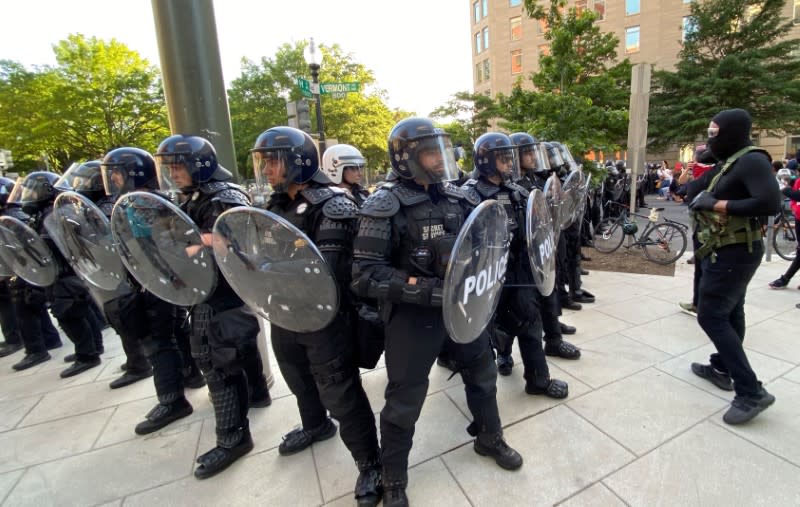On the streets of Washington, pleas for change met with batons and rubber bullets
By Andy Sullivan and Jonathan Landay
WASHINGTON (Reuters) - (Editors note that some readers may find language in paragraph 12 offensive)
They had come out by the hundreds on the streets of the U.S. capital to protest racism and police brutality. With a curfew fast approaching, they had only a few hours to make their voices heard.
Pressed against metal barriers a block from the White House, a crowd of protesters - teenagers and seniors, white, black and brown - faced a line of police wearing body armor and carrying shields on Monday evening. The protesters chanted "hands up, don't shoot" and "put your shields down."
It had been a week since a black man named George Floyd died in Minneapolis police custody after a white policeman knelt on his neck for nine minutes, prompting furious protests demanding change as well as outbursts of violence across the United States.
In Washington, Mayor Muriel Bowser voiced her support for the protests, but also established a 7 p.m. curfew to head off a repeat of the looting and property destruction inflicted on her city the previous two nights.
Fresh graffiti covered Civil War monuments and expense-account restaurants. An Army Black Hawk helicopter circled overhead, with armed troops visible in its open doors. Rubber bullets lay underfoot, remnants of the previous night's confrontations.
As the curfew approached, protesters mulled whether to stay or head home.
"It does tend to get violent later, so I'll just come out here for a few hours while I can and then leave," said James Philip, 23, a cellphone salesman from suburban Lanham, Maryland who was wearing a Dallas Cowboys face mask, a face shield and a rapper Ice Cube T-shirt.
Violence started sooner than Philip expected - initiated by the police.
THE PRESIDENT AND THE BIBLE
Half an hour before curfew, baton-swinging police fired smoke canisters, flashbang grenades and rubber bullets to drive protesters farther from the White House, enabling President Donald Trump to walk across Lafayette Park and hold up a Bible in front of St. John's Church, a house of worship visited by U.S. presidents for two centuries.
"We took a knee at the front line and the police threw tear gas - that was their response," said a young man who was taunting police and gave his name only as "X" - clad in black and wearing a military-style ammunition belt with a tattered piece of an American flag attached.
"I did five years in the military, put my life on the line in Iraq, put my life on the line in Djibouti, just to come back home and get treated like shit," the man added.
Others challenged black police officers serving in a city nearly half black to join the protest, chanting, "Quit your job."
Outside St. John's, people distributed water bottles and squirts of hand sanitizer amid the coronavirus pandemic as the rector, Father Rob Fisher, watched the protest. Fisher said that a fire set the previous night in the church's nursery did little damage before being extinguished by firefighters.
"One thing I know for sure is that whoever started it is not representative of the majority of people protesting here," Fisher added.
By night's end, police said, more than 60 people had been arrested in Washington for curfew violations or felony rioting.
Trump on Monday night blamed "professional anarchists" and "thugs" for America's urban unrest. Protesters called the violence a byproduct of centuries of oppression of African Americans, the same kind of rage behind the 1968 rioting ignited by the assassination of civil rights leader Martin Luther King that scarred parts of Washington for decades.
"It's an expression of anger. It's saying, 'I tried talking to you and you didn't listen,'" said Caneisha Mills, 36, a black Washington public school teacher.
Floyd's killing, the latest in a long line of similar incidents, came in the midst of a pandemic that has disproportionately sickened and killed black Americans and an economic downturn that has disproportionately cost them their jobs.
In Washington, protesters had plenty of opportunity for mayhem. Yet no trash cans were pitched through plate glass windows and no fires were set as hundreds marched up 14th Street in the city's Northwest section, a formerly black neighborhood now lined with high-end boutiques and pricy condos.
Only two police cars accompanied the protesters, leaving surprised motorists to pick their way through the crowds on their own - a marked contrast to the layers of armored federal police protecting the White House.
Tensions remained high. Just after 8:30 p.m., a column of police cars arrived, prompting the protesters to turn and confront them. A glass bottle shattered on the sidewalk. As the night wore on, more police arrived on the scene and started making arrests, loading zip-tied protesters into waiting vans.
"I'm ready to die tonight - for my people," Kevin Johnson, 21, who was laid off from his job at a suburban pizza restaurant amid the pandemic, said as another man loaded broken bricks into a backpack nearby.
(Reporting by Andy Sullivan and Jonathan Landay; Editing by Mary Milliken and Will Dunham)




